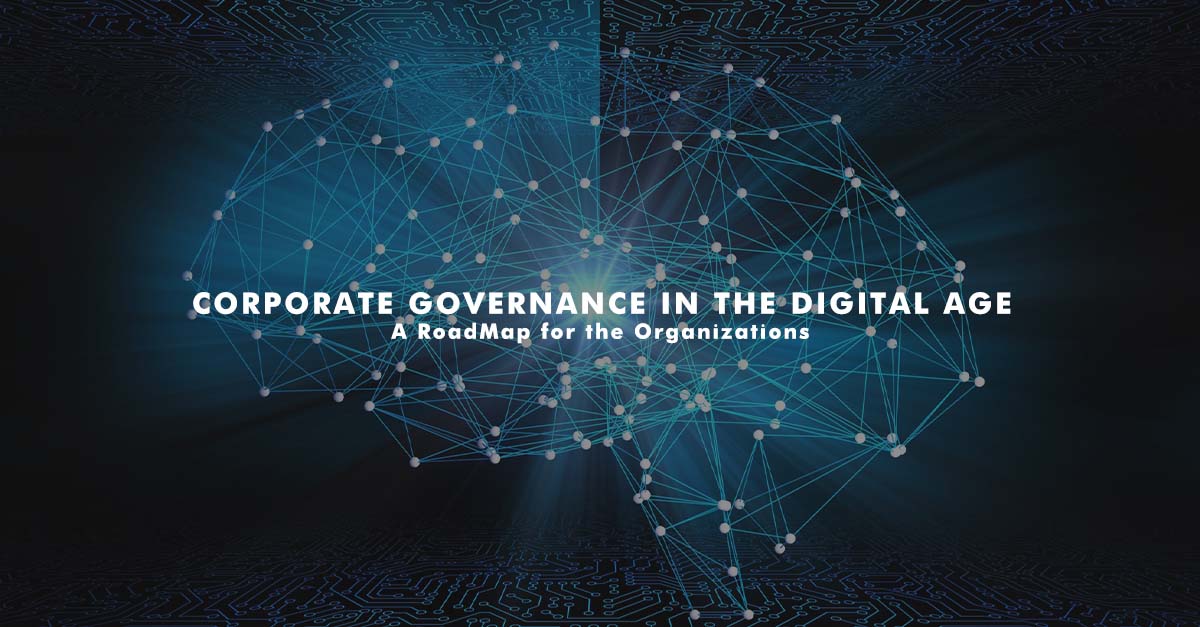
Corporate Governance in the Digital Age: A RoadMap for the Organizations
“Corporate Governance in the Digital Change has transformed to a digital form. Addressing the challenges and leveraging upon the opportunities will be a critical factor in a successful Corporate Governance among organizations.”
Corporate governance is a set of principles, mechanisms, and processes used by various organizations to perform practices to run an organization smoothly.
As the COVID-19 pandemic took place, the business practices underwent disruption, transforming themselves digitally.
Emerging technologies make corporate governance adapt to the critical business processes digitally to align the business functions digitally.
Transparency, accountability, and security are the three primary pillars for Corporate governance.
The purpose of these three pillars is the common goal of achieving a well-defined organizational structure embedded with the practices that drive the mission and vision of the business to achieve its desired goals and objectives.
Stakeholders such as employees, clients, third parties, and other stakeholders, including the board of directors, form the very backbone of Corporate Governance.
For the proper functioning of any business, these three pillars of Corporate Governance are of utmost importance.
Transparency:
Firstly, transparency means having nothing to hide. With the rise in disclosure practices, transparency has become of utmost importance. It is a means of making its processes visible to the clients, customers, and internal and external stakeholders.
Having a transparent system in the corporate governance not only makes the outside parties track the disclosures of the practices, but it also ensures the top management where strategies and the formation of the decision takes place.
Accountability:
Accountability, in simple terms, means answerability.
In any business, stakeholders invest with a motive to gain profits. Whenever anything goes wrong, they need somebody to blame on, and hence having the accountability of the business processes plays a vital role.
While accountability acts as a medium to identify flaws, it also helps identify the great things an organization does, helping the people at large.
Security:
While disclosures are a mandatory part of transparency and accountability, organizations also ensure disclosure saving and maintaining their confidentiality and data breaches.
In a business environment, where much data becomes vulnerable to exposure, only having security standards is not enough.
Organizations are thus focusing on devising a security strategy that prevents data leakage and cyber security concerns and acts as a shield in the business processes over the entire business ecosystem.
Corporate Governance In The Digital Age:
In short, corporate governance forms a set of principles, processes, and procedures to align the business practices.
Organizations in different sectors work differently, and hence having a Corporate Governance that caters to the practices aligned with the latest robust technologies and innovation is a treat to watch.
Risks are huge in businesses these days.
The cyber security risks, data breach risks, business management risks, and data governance risks all need to address as a significant priority from the organizations.
Tools Of A Resilient Corporate:
Organizations consider various tools to achieve a Risk Resilient business environment.
These tools also vary from the operations and mode of businesses in any organization. The following tools help organizations achieve the digital mode.
Organizational Structure:
Going digital and transforming existing business practices into digital ones are not as easy as it looks.
To achieve the desired business goals and objectives, the reformation of the entire organizational structure will be taken into considerations.
Analyzing the resources, raising the awareness, and creating a spectrum of resources and tools to mitigate the existing risks and prepare better for the risks that may arise.
The steps and procedures might differ from realigning the business practices and dealing with the risks.
Stakeholders Engagement:
The rising risks with digital practices, including the stakeholders, have risen in numerous ways.
The informal exchange of the dialogues and involvement of the stakeholders leads to upper management taking decisions and forming strategies.
Since digital corporate governance is the need of the hour, the digitization of practices will involve stakeholders more than ever. Furthermore, ensuring stakeholders’ engagement in the decisions and strategies will play a massive role in effective corporate governance formation.
Focus On Training And Expertise:
Supporting the risk management tools and risk aversion strategies needs expertise.
Digital corporate governance is the ones involved in the decision-making and every user of the systems.
Hence, significant investments are made in the hiring and training purpose of the individuals to create the enhanced corporate governance structure aligning with an organization’s business practice.
Covering the cost due to data breaches by investing in the training for the required experts exceeds the corporate governance objectives.
Conclusion:
Corporate governance is an integral part of any organization. Enormous focus on data governance, cyber security tools, and risk management strategies digitally leads to efficient corporate governance.
In conclusion, Corporate governance in the Digital change has transformed to a digital form.
Addressing the challenges and leveraging upon the opportunities will be critical factors to a successful Corporate Governance among organizations.





